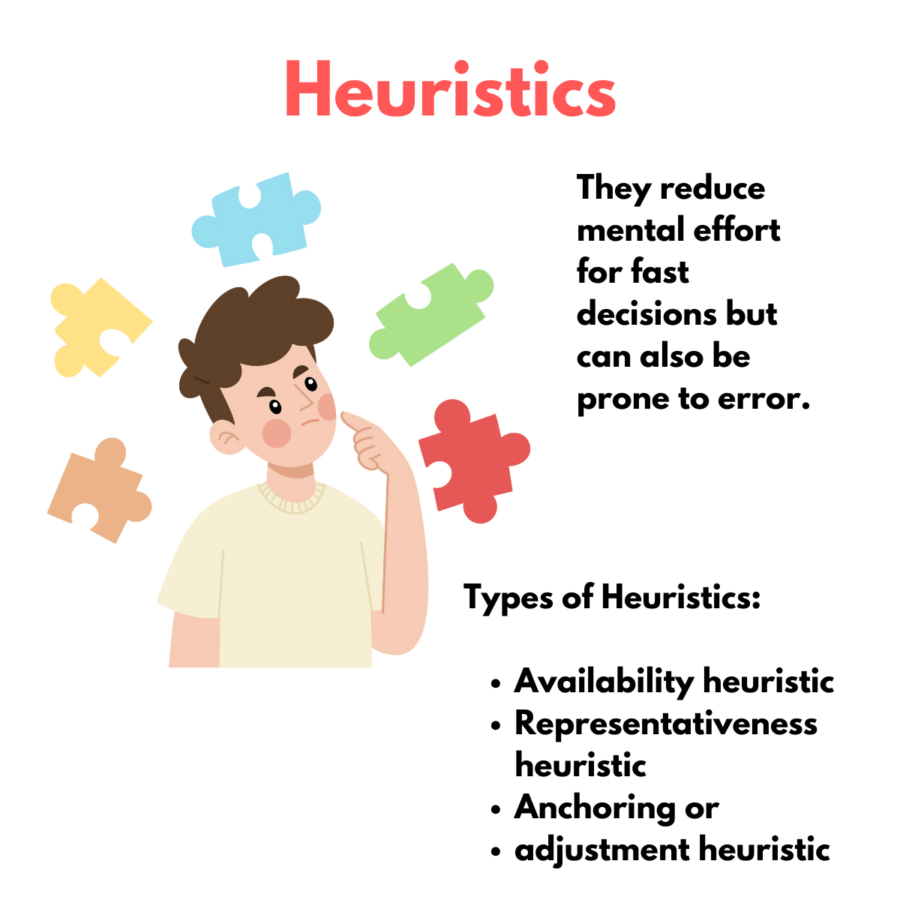Types of Heuristics in Psychology
When you are trying to solve a problem or make a decision, you don’t always have time to examine every possible answer or possibility. Sometimes, you have to rely on the information you already have to make the best guess or estimate in a limited amount of time. This is an example of using heuristics,…

When you are trying to solve a problem or make a decision, you don’t always have time to examine every possible answer or possibility. Sometimes, you have to rely on the information you already have to make the best guess or estimate in a limited amount of time.
This is an example of using heuristics, or mental ‘rules of thumb,’ that help you make choices quickly and easily.
There are many different ways to solve problems, but some take more time than others. Heuristics can be thought of as mental shortcuts that often help us make educated guesses.
Definition: A heuristic in psychology refers to a mental shortcut or rule of thumb that helps individuals make decisions or solve problems more efficiently. It is a cognitive strategy that allows us to simplify complex information and make judgments quickly.
3 Key Types of Heuristics
There are several different types of heuristics that we commonly use in our everyday lives.
Availability Heuristic
This heuristic involves making judgments based on the ease with which examples or instances come to mind. For example, if we can easily recall instances of successful outcomes from a particular option, we are more likely to choose it.
Representativeness Heuristic
This heuristic involves making judgments based on how well an object or event matches a particular prototype or stereotype. For example, if someone fits our mental image of a successful entrepreneur, we may assume they are more likely to be successful.
Anchoring and Adjustment Heuristic
The anchoring and adjustment heuristic heuristic involves starting with an initial anchor or reference point and then adjusting our judgment based on additional information. For example, when negotiating a price, we may start with a high anchor and then adjust downward based on the seller’s counteroffer.
Why We Use Different Types of Heuristics

We don’t always have the time–or the resources–to consider every possible option for every decision we make. People make hundreds of decisions each day. If we had to meticulously use trial and error or other methods to make each choice, we’d never get anything done.
Heuristics are often used when we don’t have the time or resources to gather all the necessary information for a decision.
Of course, heuristics aren’t perfect. They can also be biased and may lead to inaccurate decisions. Despite their limitations, heuristics are valuable because they allow us to make decisions quickly and with minimal effort.
There are different types of heuristics that individuals use in various situations. Some common types include availability heuristics, representativeness heuristics, and anchoring and adjustment heuristics.
Each type of heuristic has its own set of characteristics and biases. Understanding heuristics is important because they can contribute to cognitive biases, which are systematic errors in thinking. By recognizing these biases, we can become more aware of our decision-making processes and make more informed choices.
How Were These Types of Heuristics Discovered?
While we may like to believe that our choices are rooted in rationality and logic, psychologists have shown that there are certain patterns that tend to dictate how we solve the problems we face. During the 1970s, [sychologists Amos Tversky and Daniel Kahneman conducted groundbreaking studies on how people make judgments in the face of uncertainty.
Their work challenged the traditional view that humans always make rational choices based on complete information.
Tversky and Kahneman suggested that heuristics are mental shortcuts that individuals use to simplify complex problems and make judgments quickly. They identified several common heuristics, such as the availability heuristic, which involves making judgments based on how easily examples come to mind, and the representativeness heuristic, which involves making judgments based on how closely something resembles a typical example.
This research provided valuable insights into the limitations and biases associated with heuristics. They showed that heuristics can lead to systematic errors in thinking known as cognitive biases.
How We Use Different Types of Heuristics to Make Decisions?
Heuristics are an inextricable part of our daily lives, even though we are rarely aware of them. In decisions both large and small, we use heuristics to help narrow down our choices and determine which option is right for us, often based on very limited information.
For example, the availability heuristic helps us make decisions based on the ease with which examples come to mind. If we can easily recall instances of successful outcomes from a particular option, we are more likely to choose it.
Heuristics also aid in problem-solving by providing shortcuts to finding solutions. Instead of exhaustively analyzing every possible solution, heuristics allow us to quickly identify potential options based on past experiences or general rules of thumb. This can save time and mental effort, especially when we need to act quickly.
Advertisers often employ heuristics to create persuasive messages that appeal to consumers’ cognitive biases. By framing information in a certain way or using social proof, they can influence our decision-making and encourage specific actions.
Examples of Types of Heuristics
There are examples of heuristics all around us. Examining some of these examples can help give greater insight into how they shape our thinking and influence our choices.
- For example, imagine that you are going to be flying to another country for vacation. In the weeks before your flight, you find yourself recalling numerous news stories of plane crashes. Because these examples spring to mind so readily, you may overestimate the likelihood that a plane crash will occur. This is an example of the availability heuristic.
- Or imagine you deciding who to vote for in an upcoming election. You might look at the candidates and pick one based on your expectations about good leadership traits. Basing your decision on how well the candidate fits your expectations rather than on their voting record or policy platform is an example of the representativeness heuristic.
- Or imagine that you are thinking about buying a new house. You look at the list price, and then use that number as an ‘anchor’ to base your offer on. It may not necessarily indicate what the house is worth or what other similar houses are going for, but you’re still likely to use that initial number as a reference point for all future negotiations.
These examples highlight how heuristics can simplify decision-making but also demonstrate their potential limitations. By recognizing these heuristics in action, we can become more aware of their influence and make more informed choices.
Heuristics vs. Other Decision-Making Strategies
Heuristics are just one of the many strategies people utilize to make decisions. We may be more likely to rely on heuristics when:
- When need to make decisions quickly
- When we don’t have the cognitive resources to use other strategies
- When we have relevant past experience
It is important to note that heuristics and other decision-making strategies are not mutually exclusive. In fact, individuals often use a combination of heuristics and other strategies depending on the context and the specific decision at hand.
Understanding the differences between heuristics and other decision-making strategies can help individuals become more aware of their decision-making processes and make more informed choices. By recognizing the strengths and limitations of each approach, individuals can develop a more balanced and effective decision-making toolkit.
Using Different Types of Heuristics to Make Better Decisions
Using various types of heuristics can be a valuable tool for making better decisions. By understanding how heuristics work and being aware of their potential biases, individuals can harness the power of heuristics to improve their decision-making processes.
- Recognize when they are appropriate. Heuristics are particularly useful when time is limited or when there is a lack of information. Mental shortcuts can help individuals make quick and efficient decisions in these cases.
- Combine them with other decision-making strategies. While heuristics provide shortcuts, they are not foolproof and can lead to cognitive biases. By incorporating other strategies such as weighing pros and cons or conducting research, individuals can mitigate the potential biases associated with heuristics.
- Be aware of the specific heuristics being used and their potential limitations. Different types of heuristics, such as availability heuristics or representativeness heuristics, have their own biases and may not always lead to accurate judgments.
By understanding these biases, individuals can make more informed decisions and avoid common pitfalls. In conclusion, heuristics can be a powerful tool for making better decisions. Recognizing when to use them, combining them with other strategies, and being aware of their limitations can help you make better decisions.
Sources:
Bobadilla-Suarez, S., & Love, B. C. (2018). Fast or frugal, but not both: Decision heuristics under time pressure. Journal of Experimental Psychology: Learning, Memory, and Cognition, 44(1), 24–33. https://doi.org/10.1037/xlm0000419
Lindström, B., Jangard, S., Selbing, I., & Olsson, A. (2018). The role of a “common is moral” heuristic in the stability and change of moral norms. Journal of Experimental Psychology: General, 147(2), 228–242. https://doi.org/10.1037/xge0000365





